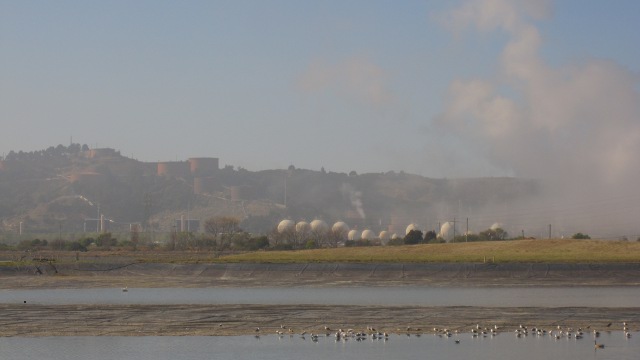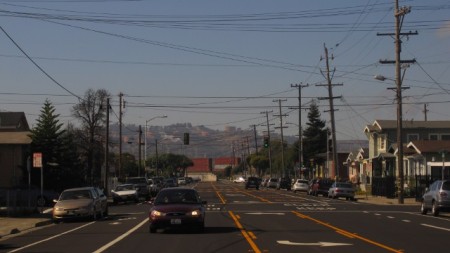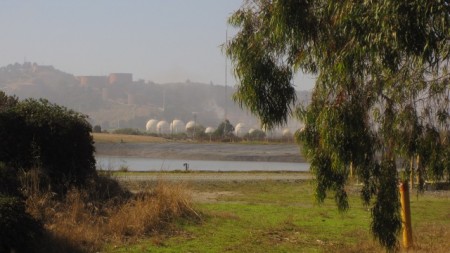What Are Richmond Residents Breathing?
On August 6th, a fire broke out at the Chevron oil refinery in Richmond, hobbling refinery operations, contributing to a statewide spike in gas prices, and sending 15 thousand people to nearby hospitals, complaining of headaches, dizziness and other ailments.
For a lot of residents in Richmond, it was the last straw in a long, rocky history with the Chevron refinery.
At a recent meeting of the Atchison Village Neighborhood Council, just over the fence from the refinery, residents John Gordon and John Kendrick, were still complaining about Chevron’s community response in the wake of the fire.
“They came out in the newspaper said there were no explosions,” says Kendrick. “I heard four!”
“Boy, are they sleazy!” Gordon exclaims, as long-time community activist Andres Soto chimes in. “We live here. We know they’re going to lie to us.”
Even among those less cynical of Chevron’s intentions, the fire re-ignited questions many have been asking for years: What does it mean to live next to the largest refinery on the West Coast? What are people here breathing?
They are difficult questions to answer in a city thick with industry and transportation.
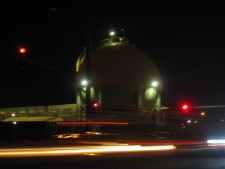
“It’s probably not all Chevron,” says Kendrick. “We’ve got the railroad cars, we got the highways, we got trucks coming going. But it’d be nice to get a breakdown to understand.”
Monitoring the air
Despite a century of industry in this area, there are only two official air-quality monitors in Richmond, and two in nearby San Pablo. They’re both run by the Bay Area Air Quality Management District. The August fire revealed a system designed to look for averages over time not illuminate emissions from specific incidents or indicate where they come from.
To Larson, an air-monitoring activist who heads the non-profit Global Community Monitor, that’s just not enough.
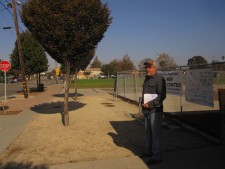
“We have a high concentration, probably hundreds of toxic emissions sources in a very small area. And the wind is almost always blowing from where those industries are to where people are breathing in north Richmond,” he says.
Pretty soon, residents will know at least a little more about what it is, exactly, they’re breathing thanks to a new network of monitors being put in by the very company many of them so deeply distrust: Chevron.
Industry fills the air-monitoring void
The six new monitors are designed to pick up common industrial chemicals including benzene and sulfur dioxide. One of them will be on, or near, the Shields-Reed Community center in North Richmond.
Says Larson, “we’re going to take a quantum leap into the 21st century when the Richmond system is in because we will then be able to better identify what the sources are.”
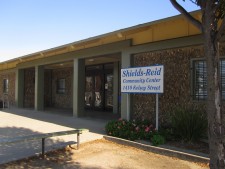
Chevron agreed to pay for this new system – including about a million dollars of equipment in addition to an online, publicly-accessible reporting system -- as part of a settlement with the city back in 2010, but the project stalled. After the August fire, the pace picked up.
The plan, says Chevron spokeswoman Heather Kulp, is to have a third-party contractor, independent from Chevron, providing real-time results and quarterly reports to the public.
“We are not filtering,” says Kulp. “We have nothing to do with the data. So the community can have a lot of confidence in this data because it’s going directly from the instruments to the web.”
Larson says he endorses this system, but the community will have to stay vigilant.
“Even after it’s up, we have to make sure that they don’t make any changes to the system or forget to pay the contractor, whatever. If we’re not watchful, the system won’t be successful in delivering information people want.”
But among those in Richmond whose job it is to keep the air clean, this whole plan is raising some eyebrows.
Will the data have teeth?
“I was surprised to see the agreement [between Chevron and the city of Richmond]”, says John Gioia, Contra Costa County Supervisor and chair of the Bay Area Air Quality Management District.
Gioia says because the monitors are being operated outside of government oversight, the results aren’t certified. Even if the monitors showed something toxic being released into the air, there’s not much officials could do about it, other than follow up with their own testing.
“The air district can't use that data to impose a fine or penalty,” he says.
Complicating things is the fact that the Air District is also stepping up its own monitoring in the wake of the fire. Plans are afoot for a new monitoring network around all five of the Bay Area’s refineries, including Chevron.
These plans are just getting started, but the idea is to make refineries pay for the cost of installing and operating that system, through fees that the District has the authority to levy.\
"Information is power."
Denny Larson, the activist, says he’s not worried about a conflict here -- the more monitors, the better. Information, he says, is power.
Larson already knows what one of the first questions will be. It has to do with a giant wastewater treatment pond that Chevron uses to filter out toxic chemicals.
Refineries in Europe often cover these ponds, to collect fumes that would otherwise drift into the neighborhood. But here, the ponds are uncovered. Larson would like to see that changed, but that’s hard to do without accurate data about what emissions the ponds produce.
“We can’t get very far without saying look, that’s a big source of toxic pollution. We want it covered and we don’t want those vapors coming into the neighborhood anymore.”
Will the air monitors give residents ammunition to make Chevron change its ways?
Chevron doesn’t think so. In fact, refinery spokeswoman Heather Kulp thinks the monitors will have the opposite effect.
“I think what they’re going to see is to understand that there are multiple sources of emissions in this community. And I also think they’re going to see that the air quality in Richmond is actually a lot better than they believe it to be.
Chevron says its six new air monitors – that’s three on the refinery, three in nearby neighborhoods -- will be up and running in a few months. The other system – those government-run monitors that could actually help set fines – could take several years.
